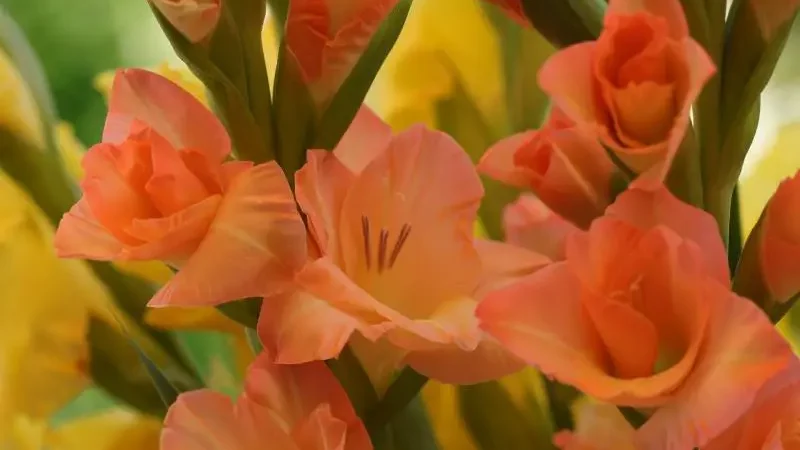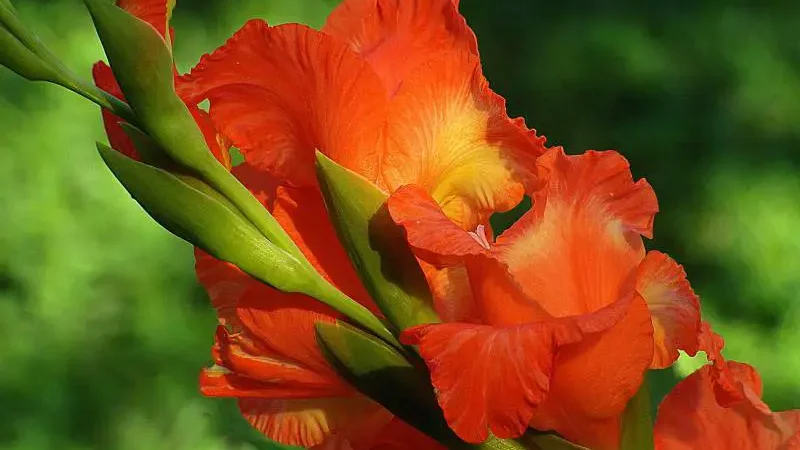When and How To Cut Gladiolus Back? [Guide]

For centuries, gladiolus plants have been known to add dramatic glamour to home gardens, but when and how to cut gladiolus black?
Perhaps you like that they stand out in flower beds during summer. These fantastic flowers come to life when the sun is bright, and the winds are less intense. They do well when planted next to walls or shielded by a hedge to act as windbreakers. They are easy to maintain, as they require less pruning.
However, pruning helps in keeping them healthy.
Knowing when and how to cut gladiolus back is essential because it adds that dramatic color burst to your flower bed.
Here is a concise guide on how to get the best out of gladiolus plants.
What are Gladiolus Plants?
Gladiolus plants are popular for flower gardens due to their vibrant trumpet-shaped blooms in various colors, from bright yellows and pinks to soft whites and purples. These beautiful plants are also suitable for container and vegetable gardens, making them a great addition to any outdoor space.
To ensure that these tall plants remain upright and not flop over, it is usually necessary to stake them. Additionally, their tall stems can be concealed behind taller plants when not in bloom, allowing for a surprising burst of color when the blooms appear.
Getting Ready To Grow Gladiolus
Gladiolus plants do well in well-aerated soil with organic manure and exposure to the sun. The ideal planting depth should be 10 inches (25.4 centimeters). These factors ensure the plants have enough moisture for healthy growth and better blooms. Gladiolus corms are planted in March and May to attain bloom succession in summer and early fall.
Avoid planting in spring as the cold weather makes the soil too cold for the corms to sprout, and if they blossom, they wilt. Always wait for deciduous plants to sprout to start planting gladiolus.
There are two ways to grow gladiolus: propagation or germinating from fresh seeds.
Propagation takes longer than planting the seeds. Meanwhile, germinating own seeds helps avoid diseases common in stalks or corms used in propagating.
Once the plants are mature, the need to cut back the gladiolus blooms into play.
Why Should We Cut Back Gladiolus?
There are many reasons to cut back gladiolus. The flowers are not wild, and cutting back gives them a dramatic and enticing new look. These are easy-to-tend blooms that are spectacular during summer.
Since they come in different hues, they give the backyard a great look. Whether they are below your windows, in front of the porch, or blended with other flowers in the garden, cutting them back gives them character. When left unattended, gladiolus loses their natural glamour.
The magic of their beauty lies in trimming at the right time.
When To Cut Gladiolus Back
The timing for cutting back gladiolus depends on how the planting was staggered. Cutting back should also be staggered for two weeks if the planting was staggered for two weeks. This might sound like too much work, but the more you stagger the planting, the longer the bloom will last. Gladiolus planted during hot summer needs to be kept where there is partial shade. This makes the blooming period longer.
However, the plant takes between three and four months to mature and bloom. On average, the bloom lasts between seven and ten days. They may last an extra day or two if the weather is cold.
Once the bloom starts to shrink, it is time to cut back, and here are steps on how to cutting gladiolus back. Some gladiolus planters are known to speed up the blooming of the plants. To do this, one must remove the top of the flower bud to let it produce more flowers and for additional uniformity when blooming.
This may appear tedious, but it adds extra sparkle to the garden.
How To Cut Gladiolus Back
Gladiolus plants are attention seekers, and the more they are attended to, the more dramatically they add a class of touch to the garden. There are several ways to cut gladiolus back.
Here are some rewarding and straightforward tips on how to cut gladiolus back:
1. Pinching Fading Gladiolus
Pinchin fading gladiolus is an easy way to prune back gladioli. This should be done throughout the entire blooming season as it keeps them neat, healthy, and appealing to the eye. The process involves removing the blooms that have already faded.
To achieve the best results, fingertips come in handy, but garden shears work wonders. Pinching away buds that have wilted paves the way for new buds to blossom. Timely cutting back the drying up blooms and leaves speeds the next batch of buds to come alive.
2. Pruning Stems
This method involves removing the entire stem that has faded buds. For better results, we recommend that you use shears or pruners. When cutting the stalk, ensure it is cut from the ground but leave the leaves.
3. Gladiolus Leaf Trimming
Dry gladiolus leaves are not a good sight in flower gardens. You should trim it and leave only the green ones. Once cut, they can be left and removed with the rest of the foliage. Avoid removing foliage early – this can delay the next blooming of the next season.
When leaves are left to dry, add nutrients for the corms through photosynthesis. Timely pruning means better and healthy blooms for the next season.

Harvesting Gladiolus
Growing gladiolus in your yard can provide beautiful cut flowers for your home. To harvest, cut the stalk at an angle when 2-3 blooms are open and leave lots of leaves on the plant. Make sure everything is clean, and place the blooms in a bucket of water. Cut off 2-3 inches of the stalk at the top to encourage the closed buds to open up.
With proper care, gladiolus stems can last 6-12 days in a vase.
Final Words
In conclusion, gladiolus flowers come in different colors, making them the best choice to include in any banquet. A gladiolus home garden saves time and allows you to plant the shades and colors that appeal to you. The different shades are easy to blend at home and cuts costs incurred at the local florist.
Growing gladiolus can be a good pastime and a source of extra income by supplying them to the local florist. They can also supplement fresh home flowers to give vases a new look. What’s more, cutting back the flowers is no rocket science; anyone can do it.
Apart from the shades, the flowers attract hummingbirds to feed on the nectar. This is an added advantage for nature lovers. There is nothing better than the sound of birds chirping around your home.
Moreover, gladiolus does well in most climates as long as they get the moisture required for better growth and blooming.